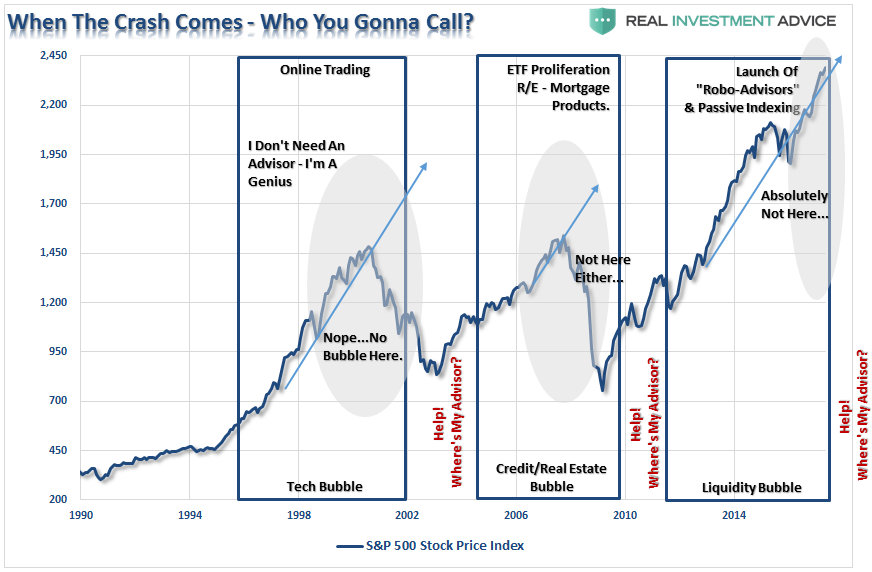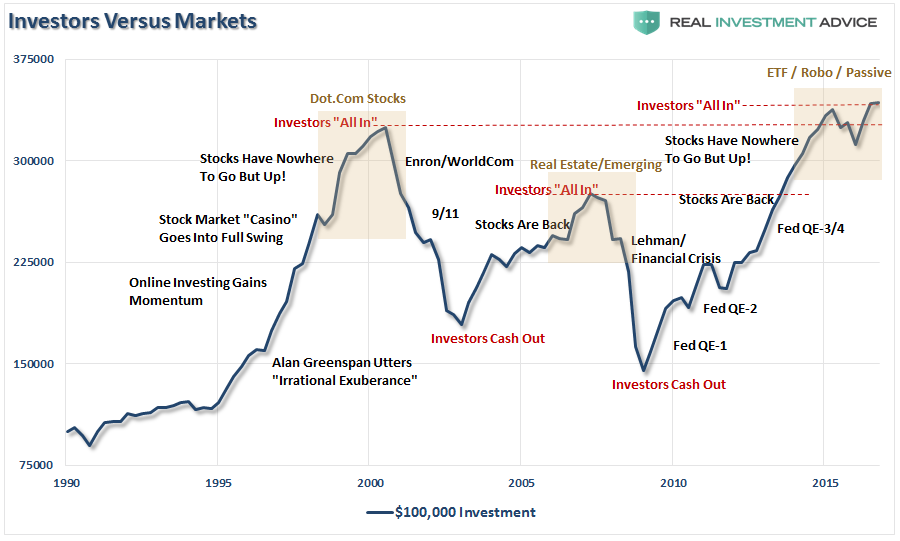| Followers | 219 |
| Posts | 247348 |
| Boards Moderated | 2 |
| Alias Born | 04/06/2006 |
Tuesday, June 27, 2017 6:31:48 AM
Signs Of Excess: Crowding & Innovation
Written by Lance Roberts | Jun, 26, 2017
I have regularly written about the many shortcomings of human psychology when it comes to investing. More importantly, while the emotions of “greed” and “fear” are the predominant drivers of not only investor behavior over time, they are also attributable to the development and delivery of the financial products that Wall Street promotes.
Wall Street firms, despite what the media advertising tells you, are businesses. As a business, their job is to develop and deliver products to investors in whatever form investor appetites demand. As markets rise and fall, investors consume products and services accordingly. During strongly rising markets the demand for “risk” related products rise. Conversely, as markets fall, the demand for safety and income rises as “risk” related losses mount. Of course, Wall Street is always happy to provide those “products” to the consumers they serve.
It is from this perspective that as we see the financial markets cycle from “boom” to “bust,” we have seen a series of product and services offerings come and go in the financial marketplace. In the early 80’s, we saw the rise of “portfolio insurance” which eventually gave way in the “Crash of ’87.”
As the bull market gained momentum in the 90’s the proliferation of mutual funds exploded as Wall Street told investors that “buying and holding” mutual funds, and letting their “experts” manage the money, was the ONLY way to invest. As Wall Street made stars out managers like Peter Lynch and Bill Miller, the demand by individual investors grew. As Wall Street quickly figured out that it was far more lucrative to collect ongoing fees rather than a one-time trading commission, the age of the “stock broker” officially died as the rise of the asset-gathering “financial consultants” gained traction. The mutual fund business was booming, and business was “brisk” on Wall Street as profits surged.
However, as the internet was developed, the next major financial innovation occurred – “online trading.” For the first time, Wall Street could tap directly into the masses and the “Wall Street Casino” officially opened. The marketplace for the delivery of products and services exploded, and Wall Street was happy to deliver a steady stream of new offerings to the newly minted “investing geniuses.” Online trading services like Schwab, E*Trade, and others blossomed as trading moved mainstream and “financial consultants” were deemed “hooligans” for charging fees for “advice” for something that a “trained monkey” could do on-line.
“Why would anyone pay an advisor and reduce their returns when all one had to do was point-and-click their way to wealth.”
Day trading shops were set up around the country along with videos, seminars, and academies all designed to teach individuals the “art of trading their way to wealth.”
That, of course, was the late 90’s and soon thereafter not much was left but broken homes and empty bank accounts. The demand for “advice” surged as individuals, desperate for hope, clung to the “words of wisdom” from the very individuals that they had chastised during the preceding bull market.
As shown in the chart below, the cycle continues to repeat itself.

After the devastating crash of “dot-com” bubble, individuals shunned stocks to jump into real estate. This was surely a “can’t lose” proposition as “everyone needs a house,” right? As the demand for real estate grew, Wall Street once again responded with a litany of products from Real Estate Investment Trusts (REIT’s) to private real estate investment vehicles and, of course, the infamous mortgage-backed security and derivative products.
As the liquidity fueled real estate market gained traction, the liquidity derived from low interest rates, cash-out refinancings and mortgage-ATM’s were dumped back into the financial markets. Making money was so easy – why would anyone ever pay a financial advisor a “fee” to manage their money for them. Once again, the mainstream media jumped into the fray touting low costs investing, indexing and launching a series of “investing contests.” There was once again nothing to worry about in the financial markets – valuations were reasonable due to low interest rates, “subprime was contained,” and it was the advent of Bernanke’s “Goldilocks” economy. What could possibly go wrong?
Of course, by the time that individuals figured out the party was over; Wall Street had already left without having to clean up the mess. For a second time, emotionally battered and financially crushed, individuals rushed to seek out the human contact of financial advisors. The need to commiserate, hear words of encouragement and be shown signs of hope were worth the “fees.” Individuals were no longer concerned with “beating some index” but rather how to protect what they had left.
Human psychology and emotional behaviors are critically important to understand as they are the one constant in an ever changing financial landscape. I have shown the following chart before which is not a new concept by any means.

Note the chart above is what has happened to a $100,000 investment in the S&P Index. Notice the difference between the two charts above. While the S&P index has soared past previous highs, a $100,000 dollar investment has just recently gotten back to even. This demonstrates the important difference about the impact of losses on a dollar-based portfolio on investments versus a market-cap weighted phantom index.
MUCH MORE @ https://realinvestmentadvice.com/signs-of-excess-crowding-innovation/
Written by Lance Roberts | Jun, 26, 2017
I have regularly written about the many shortcomings of human psychology when it comes to investing. More importantly, while the emotions of “greed” and “fear” are the predominant drivers of not only investor behavior over time, they are also attributable to the development and delivery of the financial products that Wall Street promotes.
Wall Street firms, despite what the media advertising tells you, are businesses. As a business, their job is to develop and deliver products to investors in whatever form investor appetites demand. As markets rise and fall, investors consume products and services accordingly. During strongly rising markets the demand for “risk” related products rise. Conversely, as markets fall, the demand for safety and income rises as “risk” related losses mount. Of course, Wall Street is always happy to provide those “products” to the consumers they serve.
It is from this perspective that as we see the financial markets cycle from “boom” to “bust,” we have seen a series of product and services offerings come and go in the financial marketplace. In the early 80’s, we saw the rise of “portfolio insurance” which eventually gave way in the “Crash of ’87.”
As the bull market gained momentum in the 90’s the proliferation of mutual funds exploded as Wall Street told investors that “buying and holding” mutual funds, and letting their “experts” manage the money, was the ONLY way to invest. As Wall Street made stars out managers like Peter Lynch and Bill Miller, the demand by individual investors grew. As Wall Street quickly figured out that it was far more lucrative to collect ongoing fees rather than a one-time trading commission, the age of the “stock broker” officially died as the rise of the asset-gathering “financial consultants” gained traction. The mutual fund business was booming, and business was “brisk” on Wall Street as profits surged.
However, as the internet was developed, the next major financial innovation occurred – “online trading.” For the first time, Wall Street could tap directly into the masses and the “Wall Street Casino” officially opened. The marketplace for the delivery of products and services exploded, and Wall Street was happy to deliver a steady stream of new offerings to the newly minted “investing geniuses.” Online trading services like Schwab, E*Trade, and others blossomed as trading moved mainstream and “financial consultants” were deemed “hooligans” for charging fees for “advice” for something that a “trained monkey” could do on-line.
“Why would anyone pay an advisor and reduce their returns when all one had to do was point-and-click their way to wealth.”
Day trading shops were set up around the country along with videos, seminars, and academies all designed to teach individuals the “art of trading their way to wealth.”
That, of course, was the late 90’s and soon thereafter not much was left but broken homes and empty bank accounts. The demand for “advice” surged as individuals, desperate for hope, clung to the “words of wisdom” from the very individuals that they had chastised during the preceding bull market.
As shown in the chart below, the cycle continues to repeat itself.

After the devastating crash of “dot-com” bubble, individuals shunned stocks to jump into real estate. This was surely a “can’t lose” proposition as “everyone needs a house,” right? As the demand for real estate grew, Wall Street once again responded with a litany of products from Real Estate Investment Trusts (REIT’s) to private real estate investment vehicles and, of course, the infamous mortgage-backed security and derivative products.
As the liquidity fueled real estate market gained traction, the liquidity derived from low interest rates, cash-out refinancings and mortgage-ATM’s were dumped back into the financial markets. Making money was so easy – why would anyone ever pay a financial advisor a “fee” to manage their money for them. Once again, the mainstream media jumped into the fray touting low costs investing, indexing and launching a series of “investing contests.” There was once again nothing to worry about in the financial markets – valuations were reasonable due to low interest rates, “subprime was contained,” and it was the advent of Bernanke’s “Goldilocks” economy. What could possibly go wrong?
Of course, by the time that individuals figured out the party was over; Wall Street had already left without having to clean up the mess. For a second time, emotionally battered and financially crushed, individuals rushed to seek out the human contact of financial advisors. The need to commiserate, hear words of encouragement and be shown signs of hope were worth the “fees.” Individuals were no longer concerned with “beating some index” but rather how to protect what they had left.
Human psychology and emotional behaviors are critically important to understand as they are the one constant in an ever changing financial landscape. I have shown the following chart before which is not a new concept by any means.

Note the chart above is what has happened to a $100,000 investment in the S&P Index. Notice the difference between the two charts above. While the S&P index has soared past previous highs, a $100,000 dollar investment has just recently gotten back to even. This demonstrates the important difference about the impact of losses on a dollar-based portfolio on investments versus a market-cap weighted phantom index.
MUCH MORE @ https://realinvestmentadvice.com/signs-of-excess-crowding-innovation/
Pray for A Pain Free Day!
Join the InvestorsHub Community
Register for free to join our community of investors and share your ideas. You will also get access to streaming quotes, interactive charts, trades, portfolio, live options flow and more tools.









